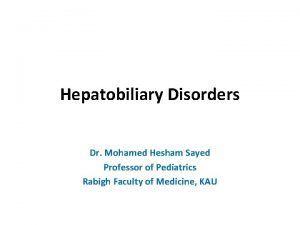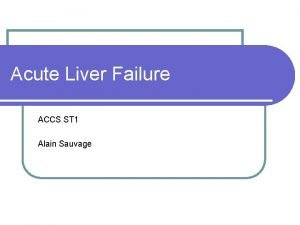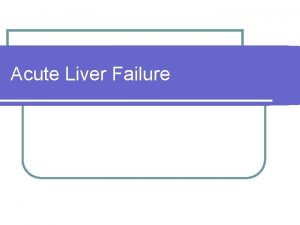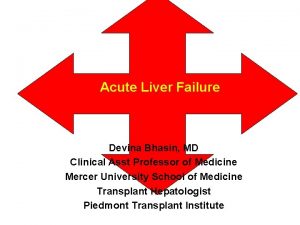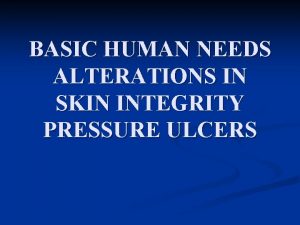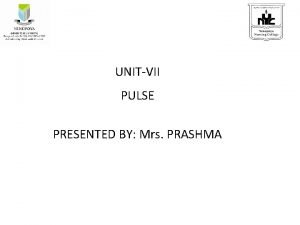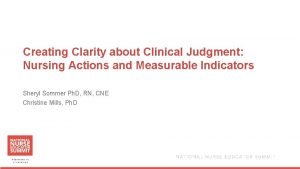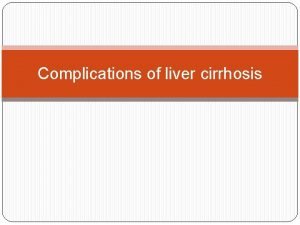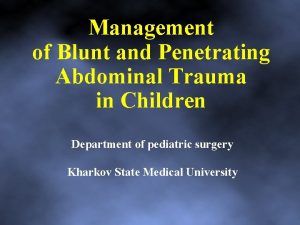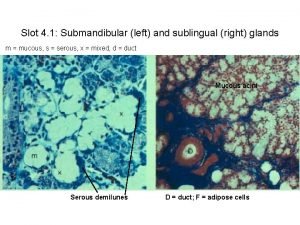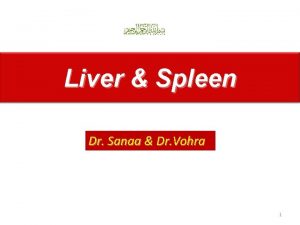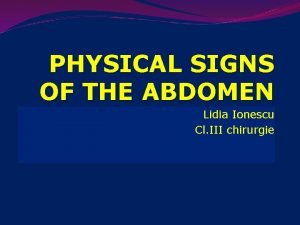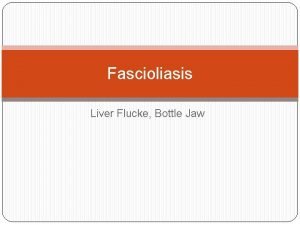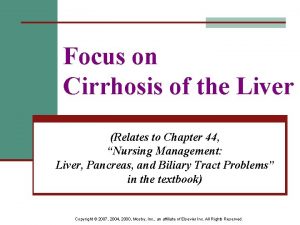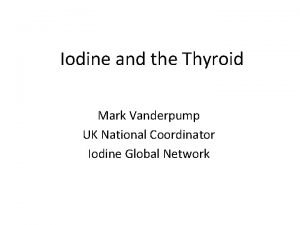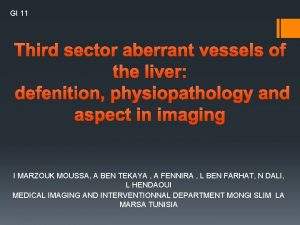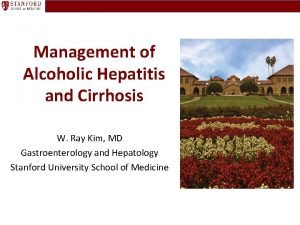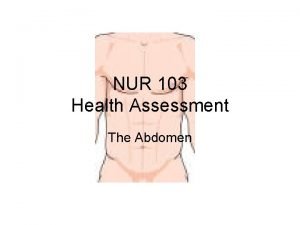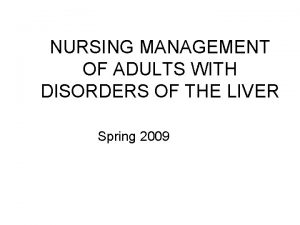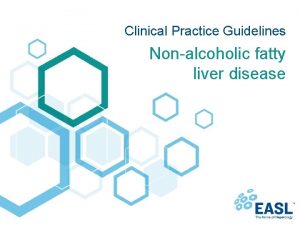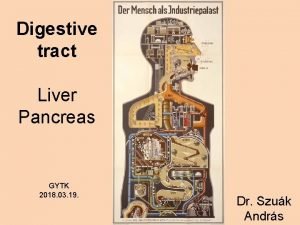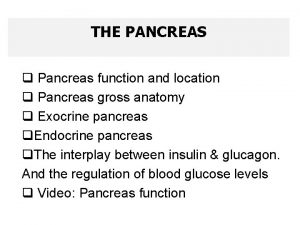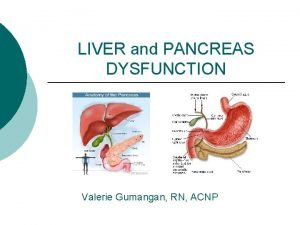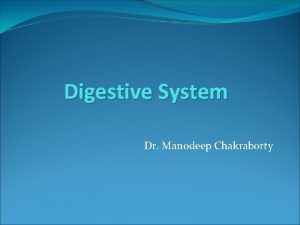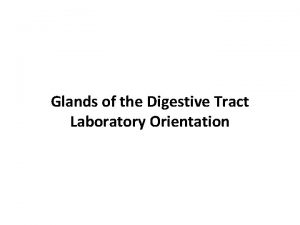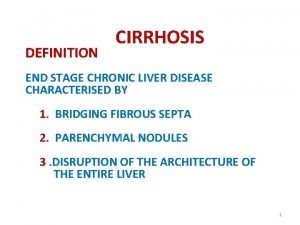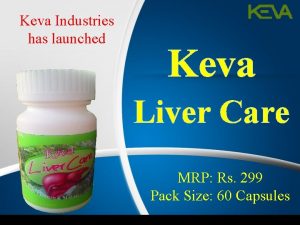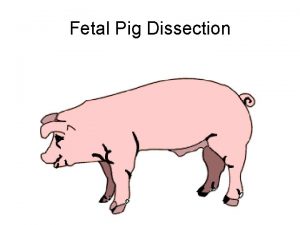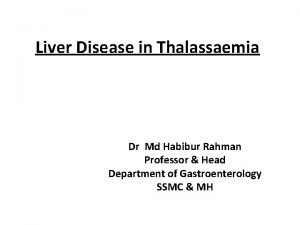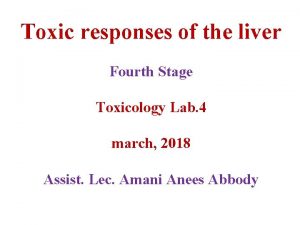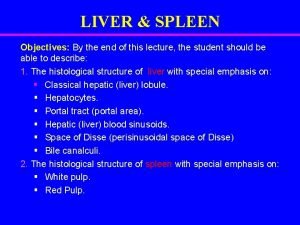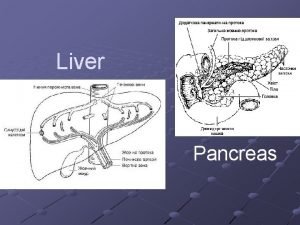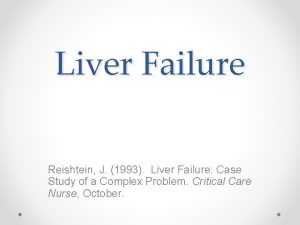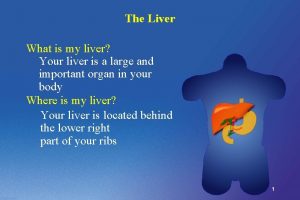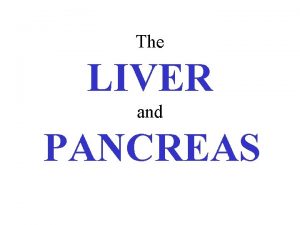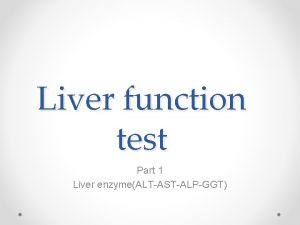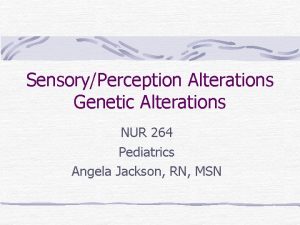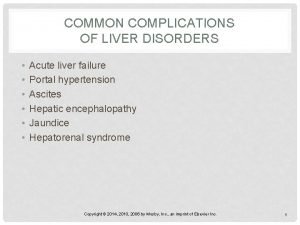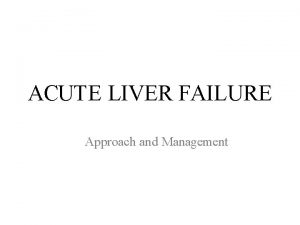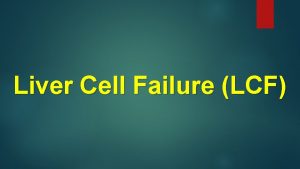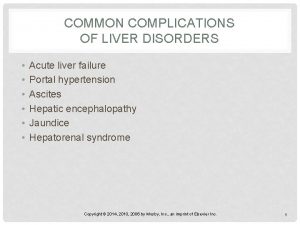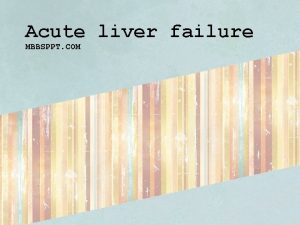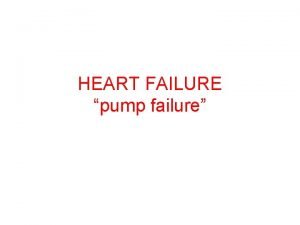liver failure The alterations that cause liver failure






















































































































- Slides: 118

liver failure • The alterations that cause liver failure fall into 3 categories: • 1 - Acute liver failure with massive hepatic necrosis • 2 - Chronic liver disease • 3 - Hepatic dysfunction without overt necrosis. 1

1 -Acute liver failure. • This is most often caused by drugs or fulminant viral hepatitis. • Acute liver failure denotes clinical hepatic insufficiency that progresses from onset of symptoms to hepatic encephalopathy within 2 to 3 weeks. • A course extending as long as 3 months is called subacute failure. 2

• The histologic correlate of acute liver failure is massive hepatic necrosis. • It is an uncommon but life-threatening condition that often requires liver transplantation. 3

2 -Chronic liver disease • This is the most common route to hepatic failure and is the end point of relentless chronic liver damage ending in cirrhosis. 4

Hepatic dysfunction without overt necrosis. • Hepatocytes may be viable but unable to perform normal metabolic function: • 1 - acute fatty liver of pregnancy (which can lead to acute liver failure a few days after onset) • 2 - tetracycline toxicity • 3 - Reye syndrome 5

Clinical features 1 -Jaundice 2 -Hypoalbuminemia →edema 3 -Hyperammonemia 4 -Fetor hepaticus (musty or sweet & sour) 5 -Palmar erythema hyperestrogenemia 6 -Spider angiomas 7 -Hypogonadism & gynecomastia 6

Complications: 1 -Multiple organ failure e. g lung 2 -Coagulopathy → bleeding def. factors II, VII, IX, X 3 -Hepatic encephalopathy 4 -Hepatorenal Syndrome 7

Alcoholic liver disease -Alcohol is most widely abused agent -Excessive ethanol consumption causes more than 60% of chronic liver disease in most Western countries and accounts for 40% to 50% of deaths due to cirrhosis. -It is the 5 th leading cause of death in USA due to : 1. Accident 2. Cirrhosis 8

Pathogenesis • Short-term ingestion of as much as 80 gm of ethanol/d (8 beers or 7 ounces of 80 -proof liquor) generally produces mild, reversible hepatic changes. • Chronic intake of 50 to 60 gm/day is considered a borderline risk for severe injury. • women seem to be more susceptible to hepatic injury than are men because of low gastric metabolism of ethanol and differences in body composition. 9

-80 – 100 mg/dl is the legal definition for driving under the influence of alcohol -44 ml of ethanol is required to produce this level in 70 kg person -In occasional drinkers, bl. Level of 200 mg/dl produces coma & death & respiratory failure at 300 -400 mg/dl 10

- Habitual drinkers can tolerate levels up to 700 mg/dl without clinical effect due to metabolic tolerance explained by 5 -10 X induction of cytochrome P-450 system that includes enzyme CYP 2 E 1 which increases the metabolism of ethanol as well as other drugs as cocaine & acetominophen 11

Forms of alcoholic liver disease 1 -Hepatic steatosis (90 -100% of drinkers) 2 -Alcoholic hepatitis ( 1 - 35% of drinkers) 3 -Cirrhosis ( 14% of drinkers) - Steatosis & hepatitis may develop independently 12

Hepatic steatosis -Can occur following even moderate intake of alcohol in form of microvesicular steatosis - initially centrilobular but in severe cases it may involve the entire lobule. -Chronic intake → diffuse steatosis -Liver is large ( 4 – 6 kg) soft yellow & greasy -Continued intake →fibrosis -Fatty change is reversible with complete absention from further intake of alcohol 13

Alcoholic hepatitis Characteristic findings : 1 -Hepatocyte swelling & necrosis -Accumulation of fat & water & proteins -Cholestasis -Hemosiderin deposition in hepatocytes & kupffer cells 2 -Mallory-hayline bodies -eosinoplilic cytoplasmic inclusions in degenerating hepatocytes formed of cytokeratin infermediate filaments & other proteins 14

-Mallory-hayline inclusions are characteristic but not pathognomonic of alcoholic liver disease, they are also seen in : 1 -Primary biliary cirrhosis 2 -Wilson disease 3 -Chronic cholestatic syndromes 4 -Hepatocellular carcinoma 15

3 -Neutrophilic reaction 4 -Fibrosis -Sinusoidal & perivenular fibrosis -Periportal fibrosis 5 -Cholestasis 6 -Mild deposition of hemosiderin in hepatocytes & kupffer cells 16

Alcoholic cirrhosis -Usually it develops slowly -Initially the liver is enlarged yellow but over years it becomes brown shrunken non-fatty organ s. t < l kg in wt. -Micronodular → mixed micro & macronodular -Laennec cirrhosis = scar tissue -Bile stasis -Mallory bodies are only rarely evident at this stage -Irreversible -It can develop rapidly in the presence of alcoholic hepatitis (within 1 -2 yrs). 17

Ethanol metabolism Ethanol → acetaldehyde CH 3 CH 2 OH CH 3 C=O H ↑ -Alcohol dehydrogenase (stomach + liver) -Cytochrome P-450 -Catalase ( liver) 18

Acetaldehyde → Acetic acid ↑ Aldehyde dehydrogenase 19

- After absorption ethanol is distributed as Acetic acid in all tissues & fluid in direct proportion to blood level - Women have lower levels of gastric alcohol dehydrogenase activity than men & they may develop higher blood Levels than men after drinking the same quantity of ethanol. 20

- Less than 10% of absorbed ethanol is excreted unchanged in urine , sweat & breathe -There is genetic polymorphism in aldehyde dehydrogenase that affect ethanol metabolism e. g 50% of chinese , vietnamase & Japanese have lowered enzyme activity due to point mutation of the enzyme. → accumulation of acetaldehyde → facial flushing, tachycardia & hyperventilation. 21

Clinical features -Hepatic steatosis ( reversible ) ↑ liver enz. Severe hepatic dysfunction is unusual -Alcoholic hepatitis • 15 -20 yr. of excessive drinking • Non-specific symptoms, malaise, anorexia, wt. loss • Hepatosplenomegaly • ↑ LFT Each bout of hepatitis → 10 -20% risk of death → cirrhosis in 1/3 in few yrs. -Cirrhosis Portal hypertension 22

• Causes of death in alcoholic liver disease 1 -hepatic failure 2 -Massive GI bleeding 3 -Infections 4 -Hepatorenal syndrome 5 -HCC in 3 -6% of cases 23

Cirrhosis • It is a diffuse process characterized by fibrosis & the conversion of liver parenchyma into nodules 24

• Main characteristics 1. Bridging fibrous septae 2. Parenchymal nodules encircled by fibrotic bands 3. Diffuse architecture disruption 25

• Types : Micronodules < 3 mm in diameter Macronodules > 3 mm in diameter 26

Causes of cirrhosis 1. Chronic alcoholism 2. Chronic viral infection HBV & HCV 3. Biliary disease 4. Hemochromatosis 5. Autoimmune hepatitis 6. Wilson disease 7. α-1 - antitrypsin deficiency 27

8. Rare causes Galactosemia Tyrosinosis Glycogen storage disease III &IV Lipid storage disease Hereditary fructose intolerance Drug induced e. g methyldopa 9. Cryptogenic cirrhosis 10% 28

Pathogenesis of cirrhosis -The mechanism of cirrhosis involves: 1 -Hepatocellular death 2 -Regeneration 3 -Progressive fibrosis 4 -Vascular changes 29

• The development of cirrhosis requires that cell death occur over long periods of time and be accompanied by fibrosis. • Fibrosis progresses to scar formation when the injury involves not only the parenchyma but also the supporting connective tissue. 30

-In normal liver the ECM collagen (types I, III, V & XI) is present only in : Liver capsule Portal tracts Around central vein 31

-delicate framework of type IV collagen & other proteins lies in space of Disse -In cirrhosis types I & III collagen & others are deposited in the space of Disse 32

• Vascular changes consisting of the loss of sinusoidal endothelial cell fenestrations and the development of portal vein-hepatic vein and hepatic artery-portal vein vascular shunts contribute to defects in liver function. 33

• Collagen deposition converts sinusoids with fenestrated endothelial channels that allow free exchange of solutes between plasma and hepatocytes to higher pressure fast-flowing vascular channels without such solute exchange. 34

• The movement of proteins (e. g. , albumin, clotting factors, lipoproteins between hepatocytes and the plasma is markedly impaired. • These functional changes are aggravated by the loss of microvilli from the hepatocyte surface which diminishes the transport capacity of the cell. 35

- The major source of collagen in cirrhosis is the perisinusoidal stellate cells (Ito cells) which lie in space of Disse - Perisinusoidal stellate cells act normally as storage cells for vit A & fat 36

• Activated stellate cells produce growth factors, cytokines, and chemokines that cause their further proliferation and collagen synthesis. • TGF-β is the main fibrogenic agent for stellate cells. 37

• Fibrosis is a dynamic process that involves the synthesis and deposition of ECM components activation of inhibitors of metalloproteinases 38

-The stimuli for the activation of stellate cells & production of collagen are : 1 -reactive oxygen species 2 -Growth factors 3 -cytokines TNF, IL-I, lymphotoxins 39

-Clinical features of cirrhosis : -Silent -Anorexia, wt loss, weakness -Complications : 1 -Progressive hepatic failure 2 -Portal hypertension 3 -Hepatocellular carcinoma 40

Portal hypertension - ↑ resistance to portal blood flow at the level of sinusoids & compression of central veins by perivenular fibrosis & parenchymal nodules - Arterial – portal anastomosis develops in the fibrous bands →increase the blood pressure in portal venous system 41

Causes of portal hypertension I. Prehepatic 1 -Portal vein thrombosis 2 -Massive splenomegaly II. Post hepatic 1 -Severe Rt. - sided heart failure 2 -Constrictive pericarditis 3 -Hepatic vein out flow obstruction III. Hepatic 1 -Cirrhosis 2 -Schistosomiasis 3 -Massive fatty change 4 -Diffuse granulomatosis as sarcoidosis, TB 5 -Disease of portal microcirculation as nodular regenerative hyperplasia 42

Clinical consequence of portal hypertension 1 -Ascitis 2 -Portosystemic shunts 3 -Hepatic encephalopathy 4 -Splenomegaly 43

Ascitis -Collection of excess fluid in peritoneal cavity -It becomes clinically detectable when at least 500 ml have accumulated -Features 1 -Serous fluid 2 -Contains as much as 3 g/ml of protein (albumin) 3 -It has the same concentration as blood of glucose, Na+, & K+ 4 -Mesothelial cells & lymphocytes 5 -Neutrophils = infection 6 -RBCs = DISSEMINATED CANCR 44

-Pathogenesis 1 -Sinusoidal ↑ Bp 2 -Hypoalbuminemia 3 -Leakage of hepatic lymph into the peritoneal cavity N- thoracic duct lymph flow is 800 -1000 ml/d in cirrhosis it may approach 20 L /day 4 -Renal retention of Na+ & water due to 2 ry hyperaldosteronism 45

Portosystemic shunt -Because of ↑portal venous pressure bypasses develop wherever the systemic & portal circulation share capillary beds -Sites: 1 -Around & within the rectum (Hemorrhoids) 2 -Gastroesophageal junction (varicies ) 3 -Retroperitoneum 4 -Falciform ligament of the liver (periumbilical & abdominal wall collaterals ) → caput medusae 46

- Gastroesophageal varicies appear in 65% of pts. with advanced cirrhosis & cause death in 50% of then due to UGI bleeding

Splenomegaly -Usu. 500 -1000 gms (N <300 gms) -Not necessarily correlated with other features of portal ↑Bp -May result in hypersplenism 48

Hepatic Encephalopthy -It is a complication of acute & chronic hepatic failure -Disturbance in brain function ranging from behavioural changes to marked confusion & sutpor to deep coma & death -The changes may progress over hrs. or days 49

-Neurological signs: Rigidity Hyper-reflexia Non – specific EEG Seizures Asterixis ( non-rhythmic rapid extension flexision movements of head & extremities). -Brain shows edema & astrocytic reaction

Pathogenesis -Physiologic factors important in development of hepatic encephalopathy : 1 -Severe loss of hepatocellular function 2 -Shunting of blood around damaged liver ↓↓ -Exposure of Brain to toxic metabolic products -Acute insult : -Chronic insult: 51 ↑ NH 3 level in blood → generalized brain edema impaired neuronal function alteration in central nervous system AA metabolism

Hepatorenal Syndrome • appears in individuals with severe liver disease. • consists of the development of renal failure without primary abnormalities of the kidneys themselves. 52

• Excluded by this definition are concomitant damage to both liver and kidney, as may occur with exposure to CCL 4 and certain mycotoxins and the copper toxicity of Wilson disease. • Also excluded are instances of advanced hepatic failure in which circulatory collapse leads to acute tubular necrosis & acute renal failure. 53

• Kidney function promptly improves if hepatic failure is reversed. • the exact cause is unknown. • systemic vasoconstriction leading to severe reduction of renal blood flow particularly to the cortex. 54

• Onset of this syndrome is typically by a drop in urine output associated with rising BUN and creatinine values. • The renal failure may increase the risk of death in the patient with acute fulminant or advanced chronic hepatic disease. 55

Drug – lnduced liver disease -Drug reactions: 1 -Predictable (intrinsic) 2 -Unpredictable (idiosyncratic) 56

• Predictable drug reactions may occur in anyone who accumulates a sufficient dose (dose-dependent). • Unpredictable reactions depend on idiosyncrasies of the host: • 1 -the host's propensity to mount an immune response to the antigenic stimulus. • 2 -the rate at which the host metabolizes the agent.

• The injury may be immediate or take weeks to months to develop. • drug-induced chronic hepatitis is clinically and histologically indistinguishable from chronic viral hepatitis or autoimmune hepatitis and hence serologic markers of viral infection are critical for making the distinction.

Predictable drugs: Acetaminophen Tetracycline Antineoplastic agents CCL 4 Alcohol Unpredictable drugs Chlorpromazine Halothane Sulfonamides Methyldopa Allopurinol

-Mechanism of drug injury : 1 -Direct toxic damage e. g acetaminophen CCl 4 mushroom toxins 2 -Immune-mediated damage 60

-Patterns of injury 1 -Hepatocellular necrosis 2 -Cholestasis 3 -Steatosis 4 -Steatohepatitis 5 -Fibrosis 6 -Vascular lesions 7 -Granuloma 8 -Neoplasms benign & malignant 61

• Pattern of Injury Morphology Examples • Cholestatic Bland hepatocellular cholestasis, without inflammation Contraceptive and anabolic steroids • Cholestatic hepatitis Cholestasis with lobular necroinflammatory activity antibiotics; phenothiazines • Hepatocellular Spotty hepatocyte necrosis Methyldoya, phenytoin necrosis Submassive necrosis, zone 3 Acetaminophen, halothane • Massive necrosis Isoniazid, phenytoin • Steatosis Macrovesicular Ethanol, methotrexate, corticosteroids, total parenteralnutrition

• Steatohepatitis Microvesicular Mallory bodies Amiodarone, ethanol • Fibrosis and Periportal and Methotrexate, isoniazid cirrhosis pericellular fibrosis enalapril • Granulomas non-caseating Sulfonamides • Vascular lesions Sinusoidal obstruction High-dose chemotherapy syndrome (veno- bush teas occlusivedisease) Budd-Chiari Oral contraceptives(OCP) syndrome Sinusoidal dilatation Oral contraceptives (OCP) Peliosis hepatis Anabolic steroids (blood-filled cavities) tamoxifen

• Neoplasms Hepatic adenoma OCP anabolic steroids HCC Thorotrast Cholangiocarcinoma Thorotrast Angiosarcoma Thorotrast, vinyl chloride

Drugs that may cause acute liver failure 1 -Acetaminophen 2 -Halothane 3 -antituberculosis drugs (rifampin, isoniazid) 4 -antidepressant monoamine oxidase inhibitors 5 -toxins as CCL 4 & mushroom poisoning 65

• The most common cause (46% of cases of acute liver failure) is acetaminophen intoxication. • about 60% of these are a consequence of accidental overdosage.

Morphology: Massive necrosis → 500 – 700 gm liver Submassive necrosis Patchy necrosis 67

• Patient survival for more than a week permits regeneration of surviving hepatocytes. • Regeneration is initially in the form of strings of ductular structures which mature into hepatocytes. • If the parenchymal framework is preserved liver architecture is restored. • With massive destruction of lobules leads to formation of nodular masses of liver cells. • Scarring may occur in patients with a protracted course of submassive or patchy necrosis representing a route for developing so-called macronodular cirrhosis

Infections of Liver 1 -Viral infections a-I. M EBV b-CMV c-Yellow fever d-Rubella , herpesvirus e-Adenoviruses enterovirus f-Hepatitis viruses A B C D E G 2 -Miliary tuberculosis 3 -Malaria 4 -Staphylococcal bacteremia 5 -Salmonelloses 6 -Candida 7 -Amebiasis 69

Hepatitis A virus • Hepatitis A ("infectious hepatitis") is a benign, self-limited disease. • incubation period of 15 to 50 days (average 28 days). • HAV does not cause chronic hepatitis or a carrier state and only rarely causes fulminant hepatitis. • Fatality rate is 0. 1%

-Transmission : Feco-oral rout -Endemic in developing countries with low hygiene & sanitation → anti-HAV Abs by the age of 10 yrs. → 50% by the age of 50 yrs.

-Clinically the disease is mild to asymptomatic affecting children of school age & rare thereafter -The virus is shed in bile & feces -The virus is shed is the stool 2 -3 wks before & 1 wk after the onset of jaundice -HAV is not shed in saliva, urine, or semen -HAV viremia is transient & b. I. Donors are not screened for the virus 72

• Waterborne epidemics may occur in developing countries where people live in overcrowded, unsanitary conditions. • Among developed countries, sporadic infections may be contracted by the consumption of raw or steamed shellfish (oysters, mussels, clams), which concentrate the virus from seawater contaminated with human sewage. • Ingestion of raw green onions contaminated with HAV caused outbreaks of the disease in the United States in 2003

Serelogic dx Anti HAV Ig. M: at the onset of symptoms → ↓ in few months Anti HAV Ig. G: appears later & persists for life -HAV vaccine is effective


Hepatitis B Virus • carrier rate of approximately 400 million. • About 80% of all chronic carriers live in Asia and the Western Pacific rim, where prevalence of chronic hepatitis B is more than 10%. • In the United States there approximately 185, 000 new infections per year.

-HBV is a hardy virus can withstand extremes of temperature & humidity -Prolonged IP 4 -26 wks -Prolonged viremia HBV remains in blood during the last stages of incubation period and during active episodes of acute and chronic hepatitis -Present in all body fluids as tears, saliva, sweat, breast milk, vaginal sec. , semen & pathological body fluids except stool 77

• vertical transmission from mother to child during birth constitutes the main mode of transmission. • horizontal transmission via: • 1 - transfusion • 2 - blood products • 3 - dialysis • 4 - needle-stick accidents among health care workers • 5 -IV drug abuse • 6 -sexual transmission (homosexual or heterosexual) • 7 -In 1/3 of patients the source of infection is unknown.

• HBV infection in adults is mostly cleared, but vertical transmission produces a high rate of chronic infection.

-Phases of infection : 1. Proliferative phase 2. Integrative phase 80

HBV antigens : 1. HBc Ag(hepatitis B core antigen) - hepatocytes 2. HBe Ag(pre-core protein) -blood 3. HBs Ag -blood -hepatocytes 4. DNA polymerase (HBV-DNA) (reverse transcriptase activity) 5. HBx protein ( transcriptional transactivator ) required for viral infectivity and may have a role in the causation of hepatocellular carcinoma by regulating p 53 degradation and expression 81

• HBs. Ag appears before the onset of symptoms, peaks during overt disease, and then declines to undetectable levels in 3 to 6 months. • Anti-HBs antibody does not rise until the acute disease is over and is usually not detectable for a few weeks to several months after the disappearance of HBs. Ag. • Anti-HBs may persist for life conferring protection • HBV-DNA, and DNA polymerase appear in serum soon after HBs. Ag, and all signify active viral replication

• Persistence of HBe. Ag is an important indicator of continued viral replication, infectivity, and probable progression to chronic hepatitis. • The appearance of anti-HBe Abs shortly after the disappearance of HBe. Ag indicates the end of the infection. • Ig. M anti-HBc becomes detectable in serum shortly before the onset of symptoms • Over a period of months the Ig. M anti-HBc antibody is replaced by Ig. G anti-HBc.

• Anti – HBs Ig. G: rise after the acute phase is over & remains detectable after wks or months after disappearance of HBs. Ag • Hepatitis B can be prevented by vaccination and by the screening of donor blood, organs, and tissues 84


Clinical syndromes associated with HBV infection 1 -Acute hepatitis with recovery 2 -Nonprogressive chronic hepatitis 3 -Progressive chronic hepatitis ending in cirrhosis 4 -Fulminant hepatitis with massive liver necrosis 5 -Asymptomatic carrier state 86


Hepatitis C Virus (HCV) • prevalence rate is 3% (0. 1% to 12%, depending on the country). • Persistent chronic infection exists in 3 to 4 million persons in the United States, where the number of newly acquired HCV infections per year dropped from 180, 000 in the mid-1980 s to about 28, 000 in the mid-1990 s due to the marked reduction in transfusion-associated HCV as a result of screening procedures and a decline of infections in intravenous drug abusers.

• The major route of transmission is: • 1 - through blood inoculation • 2 - with intravenous drug use accounting for over 40% of cases in the United States. • 3 -via blood products is now fortunately rare, accounting for only 4% of all acute HCV infections. • 4 -Occupational exposure among health care workers accounts for 4% of cases. • 5 -The rates of sexual transmission and vertical transmission are low. • 6 - Sporadic hepatitis of unknown source accounts for 40% of cases.

• HCV infection has a much higher rate than HBV of progression to chronic disease and eventual cirrhosis.


epidemiology -40000 new cases/yr in USA -1. 8% of the population ( 4 millions) are seropositive 70% of which have chronic liver disease -Anti HCV Ig. G occuring after active infection do not confer effective immunity due to genomic instability of the virus & antigenic variability -Anti HCV vaccine is not effective -Repeatd bouts of HCV infection are common causing hepatic damage -is characteristic due to reactivation of a pre existing infection or emergence of newly mutated strains 92

• The IP 2 to 26 weeks ( mean of 6 to 12 weeks). • The clinical course of acute hepatitis C is asymptomatic in 75% of individuals and is easily missed. • HCV RNA is detectable in blood for 1 to 3 weeks and is accompanied by elevations in serum aminotransferase.

• Clinical syndromes associated with HCV: • 1. Persistent infection with subclinical or asymptomatic acute infection • 2. Chronic hepatitis • 3. Fulminant hepatitis rare • 4. Cirrhosis 20% • 5. Hepatocellular carcinoma 94

Serological diagnosis • HCV RNA is detectable in bl. For 1 – 3 wks peak coincides with ↑ in serum transaminases • Anti HCV Abs detected in 50 – 70% of patients during symptomatic acute infection • In 30 – 50% of patients the anti HCV Abs emerge after 3 – 6 wks • In chronic HCV infection circulating HCV-RNA persists despite the presence of Abs in many patients ( > 90%) 95


Hepatitis D Virus -Hepatitis delta virus -Replication defective virus -Causes infection only when it is encapsulated by HBs. Ag -I. P 4 – 7 wks in superinfection 97

• 8% among HBs. Ag carriers in southern Italy to as high as 40% in Africa and the Middle East. • HDV infection is uncommon in Southeast Asia and China, areas in which HBV infection is endemic. • In the United States HDV infection is largely restricted to drug addicts and individuals receiving multiple transfusions (e. g. hemophiliacs who have prevalence rates of 1% to 10%).

• Delta hepatitis arises in two settings: • (1) acute coinfection after exposure to serum containing both HDV and HBV • (2) superinfection of a chronic carrier of HBV with a new inoculum of HDV. • Most coinfected individuals can clear the viruses and recover completely. • in superinfected individuals there is an acceleration of hepatitis, progressing to more severe chronic hepatitis 4 to 7 weeks later.

• Routes of transmission: • Parenteral (close personal contact)

• HDV Ag are detectable in the blood and liver just before and in the early days of acute symptomatic disease. • Ig. M anti-HDV antibody is the most reliable indicator of recent HDV exposure, but its appearance is transient. • acute coinfection by HDV and HBV is best indicated by detection of Ig. M against both HDV Ag and HBc. Ag • With HDV superinfection, HBs. Ag is present in serum; and anti-HDV antibodies (Ig. M and Ig. G) persist in low titer for months or longer.

Serologic diagnosis. HDV-RNA is detectable in blood & liver just prior to & in early days of acute symptomatic disease . Anti HDV Ig. M = recent HDV infection. Anti HDV Ig. M appears late & freq. short-lived. Coinfection : Ig. M against HDV Ag & HBV Ag. Superimposed infection: anti HDV Ig. M & HBs. Ag 102

Hepatitis E virus • HEV hepatitis is an enterically transmitted, waterborne infection occurring primarily beyond the years of infancy. • HEV is endemic in India • Prevalence rates of anti-HEV Ig. G antibodies approach 40% in the Indian population. • Sporadic infection seems to be uncommon & occurs mainly in travelers and accounts for more than 50% of cases of sporadic acute viral hepatitis in India.

- Water-borne infection Young – middle – aged adults Rare in children Endemic infection in India, Africa, Mexico…… Sporadic infection is uncommon & occurs mainly in travelers - Self-limiting mild disease except in pregnant women with high mortality rate (20%) - I. P: 6 wks ( range 2 -8 wks) - No chronic liver disease or carrier state 104

Serelogy -HEV-RNA can be detected in stool & liver before the onset of clinical symptoms -Anti HEV-Ig. M appears during acute illness & replaced by Ig. G when symptoms resolve (ie in 2 – 4 wks) 105

Clinicopathologic Syndromes 1 -Acute asymptomatic : serologic evidence only A B C D E 2 -Acute symptomatic hepatitis icteric or anicteric A B C D E 3 -Chronic hepatitis with or without progression to cirrhosis B &C 4 -Fulminant hepatitis with massive or submassive hepatic necrosis B, D A & C very rare 5 -Chronic carrier state B, C 106

Acute asymptomatic infection with recovery -Minimally ↑ serum tranaminases -HAV & HBV infections are freq. subclinical in childhood period -HCV infection is subclinical in 75% of the cases 107

Acute symptomatic infection with recovery -Can be caused by any hepatotropic viruses although it is uncommon in HCV infection -Phases: 1 -Incubation period 2 -Symptomatic preicteric phase . Malaise. General fatigability. Nausea. Loss of appetite. Fever, headaches, muscle pain, diarrhea. 10% of pts. Develop serum sickness-like synd. esp. with HBV infection (fever, rash, arthralgia ) due to circulating immune complexes 108

3 -Symptomatic icteric phase. Usual in adults but not children with HAV. Absent in 50% of cases of HBV & the majority of HCV. Conj. hyperbilirubinemia, dark colored urine , dark stool, pruritus . Prolonged PT, hyperglobulinemia, ↑ serum alkaline phosphatase 109

• 1 - diffuse swelling (ballooning degeneration • 2 - cholestasis, with bile plugs in canaliculi and brown pigmentation of hepatocytes. • 3 -Fatty change is mild and is unusual except with HCV infection. • 4 - Whether acute or chronic, HBV infection may generate "ground-glass" hepatocytes • a finely granular, eosinophilic cytoplasm shown by electron microscopy to contain massive quantities of HBs. Ag in the form of spheres and tubules. • Other HBV-infected hepatocytes may have "sanded" nuclei, resulting from abundant intranuclear HBc. Ag. Body_ • 5 - patterns of hepatocyte death are seen.

• 6 -confluent necrosis of hepatocytes may lead to bridging necrosis • 7 -lobular disarray • 8 -Inflammation. • 9 - Kupffer cells undergo hypertrophy and hyperplasia, and are often laden with lipofuscin pigment caused by phagocytosis of hepatocellular debris. • 10 The portal tracts are usually infiltrated with a mixture of inflammatory cells. • 11 -interface hepatitis). • 12 -bile duct proliferation

Fulminant hepatitis • Hepatic insufficiency that progresses from onset of symptoms to hepatic escepholopathy in 2 -3 wks • Subfulminant ( up to 3 mon) 112

Causes : 1 -Viral hepatitis 50 – 65% B, C, E HBV 2 x > HCV 2 -Drugs & chemical 25 - 50% e. g Isoniazid , halothane , methyldopa & acetominophen 3 -Obstruction of hepatic vein 4 -Wilson’s disease 5 -Acute fatty change of pregnancy. 6 -Massive tumor infiltration 7 -Reactivation of chronic hepatitis B 8 -Acute immune hepatitis

• Morphology -↓ liver size ( 500 – 700 gm) -Necrosis of hepatocytes -Collapsed reticulin tissue -Inflammatory infillrate -Regenerative activity of hepatocytes -Fibrosis 114

Chronic Hepatitis • Symptomatic, biochemical or serelogic evidence of continuing or relapsing hepatic disease for more than 6 months with histologically documented inflammation and necrosis • Progressive or non progressive • HBV , HCV, HBV-HDV 115

Morphology of chronic hepatitis • Mild to severe 1. Protal inflammation 2. Lymphoid aggregate 3. Necrosis of hepatocytes-councilman bodies 4. Bile duct damage 5. Steatosis 6. Interface hepatitis 7. Bridging necrosis & fibrosis 8. Fibrosis 9. Ground-glass appearance 10. Sanded nuclei 11. Lobular disarray 116

Carrier state • carriers are • (1) those who harbor one of the viruses but are suffering little or no adverse effects • (2) those who have nonprogressive liver damage but are essentially free of symptoms or disability • Both constitute reservoirs of infection. 117

Predisposing factors • 1 -HBV infection early in life, particularly through vertical transmission during childbirth, produces a carrier state 90% to 95% of the time. • only 1% to 10% of HBV infections acquired in adulthood yield a carrier state. • 2 -impaired immunity • 3 -HBV, HCV, ? HDV
 Thơ thất ngôn tứ tuyệt đường luật
Thơ thất ngôn tứ tuyệt đường luật Tôn thất thuyết là ai
Tôn thất thuyết là ai Ngoại tâm thu thất chùm đôi
Ngoại tâm thu thất chùm đôi Chiến lược kinh doanh quốc tế của walmart
Chiến lược kinh doanh quốc tế của walmart Gây tê cơ vuông thắt lưng
Gây tê cơ vuông thắt lưng Block xoang nhĩ độ 2 type 1
Block xoang nhĩ độ 2 type 1 Tìm vết của mặt phẳng
Tìm vết của mặt phẳng Sau thất bại ở hồ điển triệt
Sau thất bại ở hồ điển triệt Thơ thất ngôn tứ tuyệt đường luật
Thơ thất ngôn tứ tuyệt đường luật Hãy nói thật ít để làm được nhiều
Hãy nói thật ít để làm được nhiều Neonatal liver failure
Neonatal liver failure Encephalopathy stages
Encephalopathy stages Hepatic encephalopathy staging
Hepatic encephalopathy staging Transaminitis definition
Transaminitis definition Cushings triad
Cushings triad Ventricular escape rhythm
Ventricular escape rhythm Failure to capture vs failure to sense
Failure to capture vs failure to sense Site:slidetodoc.com
Site:slidetodoc.com Alterations in skin integrity
Alterations in skin integrity Alterations in various aspects of society over time.
Alterations in various aspects of society over time. Bare land strata insurance
Bare land strata insurance What is a collapsing pulse
What is a collapsing pulse Alterations in the structure of an organism
Alterations in the structure of an organism Clinical judgement sample items a ati
Clinical judgement sample items a ati Alterations in urinary elimination
Alterations in urinary elimination Alterations of chromosome structure
Alterations of chromosome structure Complications of cirrhosis
Complications of cirrhosis Proximate causation vs ultimate causation
Proximate causation vs ultimate causation Imprinting examples in animals
Imprinting examples in animals Ter thin client
Ter thin client Proximate cause and ultimate cause
Proximate cause and ultimate cause Cái miệng bé xinh thế chỉ nói điều hay thôi
Cái miệng bé xinh thế chỉ nói điều hay thôi Thế nào là hệ số cao nhất
Thế nào là hệ số cao nhất Frameset trong html5
Frameset trong html5 Từ ngữ thể hiện lòng nhân hậu
Từ ngữ thể hiện lòng nhân hậu Tư thế ngồi viết
Tư thế ngồi viết Thế nào là giọng cùng tên? *
Thế nào là giọng cùng tên? * Mật thư anh em như thể tay chân
Mật thư anh em như thể tay chân Các châu lục và đại dương trên thế giới
Các châu lục và đại dương trên thế giới Tư thế worms-breton
Tư thế worms-breton Hổ đẻ mỗi lứa mấy con
Hổ đẻ mỗi lứa mấy con đại từ thay thế
đại từ thay thế Diễn thế sinh thái là
Diễn thế sinh thái là Vẽ hình chiếu vuông góc của vật thể sau
Vẽ hình chiếu vuông góc của vật thể sau Các châu lục và đại dương trên thế giới
Các châu lục và đại dương trên thế giới Bổ thể
Bổ thể Thế nào là mạng điện lắp đặt kiểu nổi
Thế nào là mạng điện lắp đặt kiểu nổi Lời thề hippocrates
Lời thề hippocrates Vẽ hình chiếu đứng bằng cạnh của vật thể
Vẽ hình chiếu đứng bằng cạnh của vật thể Phép trừ bù
Phép trừ bù Quá trình desamine hóa có thể tạo ra
Quá trình desamine hóa có thể tạo ra Chúa sống lại
Chúa sống lại Sự nuôi và dạy con của hổ
Sự nuôi và dạy con của hổ điện thế nghỉ
điện thế nghỉ Dot
Dot Nguyên nhân của sự mỏi cơ sinh 8
Nguyên nhân của sự mỏi cơ sinh 8 Công thức tiính động năng
Công thức tiính động năng Tỉ lệ cơ thể trẻ em
Tỉ lệ cơ thể trẻ em Thiếu nhi thế giới liên hoan
Thiếu nhi thế giới liên hoan Fecboak
Fecboak Một số thể thơ truyền thống
Một số thể thơ truyền thống Kể tên các môn thể thao
Kể tên các môn thể thao Hát kết hợp bộ gõ cơ thể
Hát kết hợp bộ gõ cơ thể Sơ đồ cơ thể người
Sơ đồ cơ thể người Tư thế ngồi viết
Tư thế ngồi viết Các số nguyên tố là gì
Các số nguyên tố là gì đặc điểm cơ thể của người tối cổ
đặc điểm cơ thể của người tối cổ Phản ứng thế ankan
Phản ứng thế ankan Trời xanh đây là của chúng ta thể thơ
Trời xanh đây là của chúng ta thể thơ Voi kéo gỗ như thế nào
Voi kéo gỗ như thế nào ưu thế lai là gì
ưu thế lai là gì Thẻ vin
Thẻ vin Liver injury grading
Liver injury grading Esophagogastric junction
Esophagogastric junction Splenic ligaments
Splenic ligaments Anna neary
Anna neary English method emulsion
English method emulsion Shifting dullness
Shifting dullness Cld vs dcld
Cld vs dcld Histology of liver
Histology of liver Stigmata of chronic liver disease
Stigmata of chronic liver disease Stomach anatomy corpus
Stomach anatomy corpus Unbillicus
Unbillicus Peristaltic waves
Peristaltic waves Liver flucke
Liver flucke Types of cirrhosis
Types of cirrhosis Liver place in body
Liver place in body Cantlie line
Cantlie line Dr mark vanderpump
Dr mark vanderpump Pes statement for cirrhosis
Pes statement for cirrhosis Liver defenition
Liver defenition What is the primary function of the liver
What is the primary function of the liver Porta hepatis
Porta hepatis Alcoholic liver disease
Alcoholic liver disease Dextro prefix
Dextro prefix Greg leos
Greg leos Hepatorenal recess
Hepatorenal recess Lobus quadratus liver
Lobus quadratus liver Www.brainpopcom
Www.brainpopcom Abnormal percussion sounds of abdomen
Abnormal percussion sounds of abdomen Esophageal varices nursing management
Esophageal varices nursing management Non-alcoholic fatty liver disease (nafld)
Non-alcoholic fatty liver disease (nafld) Space of disse
Space of disse Location of pancrease
Location of pancrease Posticteric phase
Posticteric phase An hour later the front door opened nervously
An hour later the front door opened nervously Porosis of the liver
Porosis of the liver Normal liver span
Normal liver span Ginivitis
Ginivitis Striated duct
Striated duct Chronic liver desease
Chronic liver desease Keva liver care
Keva liver care Whitman.edu virtual pig
Whitman.edu virtual pig Stigmata of chronic liver disease
Stigmata of chronic liver disease Grassland
Grassland Liver cells organelles
Liver cells organelles Space of disse histology
Space of disse histology Heat stiffening and cold stiffening
Heat stiffening and cold stiffening Liver and pancreas function
Liver and pancreas function










